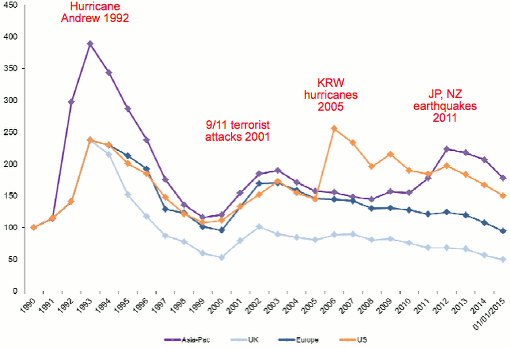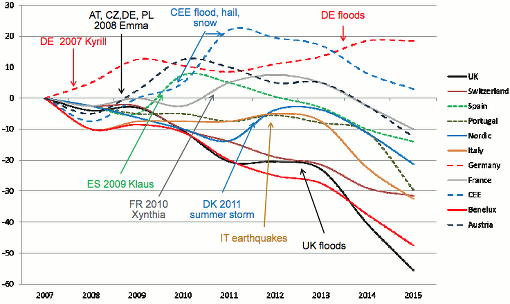The reinsurance market cycle has changed, broker Guy Carpenter said at a press briefing last week. The market cycle no longer responds in the same way to loss events, with a reinsurance market that responds locally and regionally to losses expected to be the norm.
Senior executives from Guy Carpenter discussed the recent January reinsurance renewals, what the broker saw in the way of price changes and trends that are emerging in the evolving reinsurance market. One of the trends discussed was the reinsurance cycle and how it has changed in response to more abundant and efficient capital, which can enter and exit the market more easily than ever before.
Looking at pricing trends using the Guy Carpenter Rate On Line Index, the broker believes that since 2009 its RoL Index has declined by approximately 25%. Looking at this Index broken down by key regions of the world shows an interesting picture of a changing reinsurance cycle.
First here’s the Guy Carpenter Global Property Catastrophe RoL Index, which merges the regions into a single index showing how the market has responded to catastrophe events in the past. You can clearly see the spikes post-cat event and also the steady slide in pricing over the last few years.

Global property catastrophe rate-on-line index - Source: Guy Carpenter
In the past when the reinsurance market faced a major catastrophe loss event, such as hurricane Andrew in 1992, the impact of the loss was mutualised or shared across the reinsurance industry and payback was expected, Nick Frankland, CEO of EMEA Operations at Guy Carpenter explained.
This payback affected rates across every region of the world in 1992, showing that reinsurers charged more for renewals in regions which were not affected by the catastrophe event and that the reinsurance buyers swallowed this and paid up for their coverage.
This is no longer the case. By 2005 when the Katrina, Rita, Wilma (KRW) hurricanes struck the United States, the reinsurance market had benefited from large amounts of new capital thanks to reinsurance start-ups, sidecars, catastrophe bonds and other ILS structures. This abundance of capital meant that rates only increased in the U.S., the loss affected region, as can be seen from the graph below.

Regional property catastrophe reinsurance RoL Index - Source: Guy Carpenter
So the reinsurance market used to respond as a market to major catastrophe events, sharing the burden and benefiting across the industry from the payback. Now, this has changed. “Essentially, what you’ve got now is a market that responds locally and regionally,” Frankland said.
“The reinsurance market is no longer subsidising across regions,” Chris Klein, Head of Strategy Management for the UK and EMEA regions at Guy Carpenter commented. While the reinsurance cycle is unlikely to respond as severely to losses in the future, at least while capital in the sector remains high, there are still significant, localised increases in rate-on-line due to regional or country specific catastrophe events.
Klein showed another slide which shows this localised response to losses at a more granular level, with a breakdown of Europe by country.

European property catastrophe rate-on-line trends 2007 to 2015 - Source: Guy Carpenter
The overall secular trend, while plenty of capacity remains available, is for rates moving downwards but punctuated by localised loss events which can turn rates in specific markets, Klein continued.
This trend may still be evolving. While the shift from market wide payback for reinsurers, to a more regional or localised payback, changed with the influx of reinsurance capacity in the early 2000’s, with all the capital now entering the sector from both traditional and alternative sources the way rates respond to loss events may be muted and perhaps even more localised in the future.
This trend has implications for insurance and reinsurance linked investors, as in the future we could see opportunities for ILS managers and reinsurance funds to target loss affected regions or locales in order to achieve or access better rates. This could in the future lead to a much more localised approach to diversifying an insurance linked investment portfolio.
We’ve discussed the way the reinsurance cycle is changing in a number of other articles which you can find using these links:
– Evolving market, changing dynamics may end the traditional cycle: Willis.
– Capacity drives the reinsurance cycle, least conservative sets the price.
– Will pension funds, alternative capital & ILS kill the reinsurance cycle?
Also read our other coverage of Guy Carpenter’s renewals report and briefing:
– Alternative capital grows share at reinsurance renewals: Guy Carpenter.
– Reinsurance is on an inevitable road to somewhere different: Guy Carpenter.
 View all of our Artemis Live video interviews and subscribe to our podcast.
View all of our Artemis Live video interviews and subscribe to our podcast.
All of our Artemis Live insurance-linked securities (ILS), catastrophe bonds and reinsurance video content and video interviews can be accessed online.
Our Artemis Live podcast can be subscribed to using the typical podcast services providers, including Apple, Google, Spotify and more.































